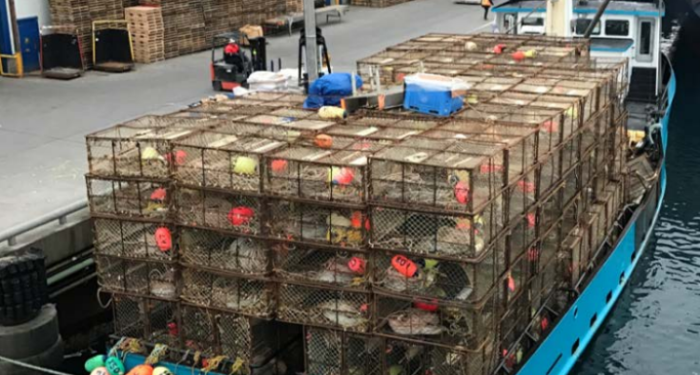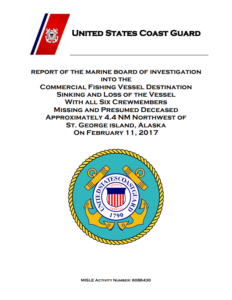The US Coast Guard released its report on the sinking of the commercial fishing vessel (CFV) ‘Destination’, which took place on February 9, 2017. The 110-foot vessel sank while it was sailing in the Bering Strait, and six crewmembers died.
The incident
On Thursday, February 9, 2017, the US flagged Commercial Fishing Vessel (CFV) ‘Destination’, left Trident Seafoods in Dutch Harbor, Alaska with six crewmembers on board heading to offload bait at the Trident Seafoods facility in St. Paul, Alaska. From St. Paul, the vessel would sail west to the snow crab fishing grounds. Earlier the same day, the US National Weather Service (NWS) issued marine forecasts that warned of heavy freezing spray conditions for the region.
[smlsubform prepend=”GET THE SAFETY4SEA IN YOUR INBOX!” showname=false emailtxt=”” emailholder=”Enter your email address” showsubmit=true submittxt=”Submit” jsthanks=false thankyou=”Thank you for subscribing to our mailing list”]
During the morning of February 11, 2017, ‘Destination’ transited along the western leeward side of St. George Island, and a little later it transited 4.4 NM northwest of Dainoi Point located at the northwest side of St. George Island. There, it slowed its speed and made a hard starboard turn into the seas and northeastern winds. After the starboard turn, the vessel suddenly lost maneuverability. Its heading changed to the west while it also drifted to the north. The ship began taking boarding seas causing it to flood and eventually sink. A little later, its Automated Identification System (AIS) stopped transmitting.
After the sinking, the US Coast Guard’s District 17 (D17) Command Center located in Juneau, Alaska received a 406 MHz Electronic Position Indicating Radio Beacon (EPIRB) distress alert transmitting near St. George Island. After watchstanders confirmed the EPIRB’s registration belonged to the ‘Destination’ and attempts to hail the vessel failed, the USCG started Search and Rescue (SAR) operations.
Numerous US Coast Guard aircraft and Good Samaritan vessels took part in SAR operations. By mid-day, US Coast Guard aircrews found a debris field in the general area of the EPIRB distress alert, and a Good Samaritan vessel recovered the transmitting EPIRB, a lifering and crab pot buoys belonging to the ‘Destination’. SAR operations did not locate any survivors or the ship’s liferaft. After three days of SAR operations, the US Coast Guard stopped the search on February 14, 2017.
Probable cause
The USCG said that the primary causal factors that directly contributed to the casualty include:
- The vessel’s unsafe stability conditions due to the carriage of heavier crab pots that exceeded the weight used in the stability instructions;
- Additional weight and stability stress from bait loaded high on the vessel;
- Excessive ice accumulations from freezing spray;
- Downflooding from the open number 3 hold access hatch.
Moreover, other causal factors include the captain’s inability to:
- Load in accordance with the vessel’s stability information book;
- Prevent excessive icing accumulations from the prevailing freezing spray conditions;
- Secure the number 3 hold access hatch while transiting.
Furthermore, contributing to the casualty was the owner’s failure to choose a qualified individual to carry out tests or calculations necessary to evaluate the vessel’s stability and update the stability instructions to reflect heavier crab pots and other alterations to the vessel.
Accordingly, the owner did not provide the captain with accurate information to maintain the vessel in a satisfactory stability condition.
Recommendations
In order to prevent similar incidents from happening in the future, the USCG proceeded to the following suggestions:
- Recommend District 13 and District 17 conduct education and outreach to promote awareness, compliance, and training opportunities with CFV stability instructions requirements of 46 CFR 28 Subpart E – Stability.
- Recommend District 13 and District 17, consistent with COMDTINST 16711.13B, conduct a targeted oversight audit on all BSAI crabbing vessels operating or home ported in their respective area of responsibility.
- Recommend District 17 develop policy regarding SSCs and ADF&G 24-hour notice regulations.
- Recommend District 13 and District 17 CFVEs use direct verification to weigh the vessel’s crab pots during dockside safety examinations and SSCs.
- Recommend Commandant conduct a targeted oversight audit on all CFVs subject to the stability requirements of 46 CFR, Subpart E.
- Recommend Commandant amend 46 CFR 28.530 – Stability Instructions, to require owners to ensure the qualified individual includes within the stability instructions the assumed weight of crab pots used within the stability calculations.
- Recommend Commandant amend 46 CFR 28.550- Icing, to reflect the intent of the icing regulations as indicated in the preamble to the final rule.
- Recommend Commandant amend 46 CFR Part 28, Subpart E – Stability, to require CFV owners and captains to present evidence of course completion after attending Coast Guard approved stability training.
- Recommend Commandant amend 46 CFR Part 28, Subpart E – Stability, to require CFVs owners to notify the Coast Guard when the vessel undergoes modifications, conversions or substantial alterations and if the owner selected a qualified individual to conduct a stability assessment.
- Recommend Commandant amend 46 CFR Part 28, Subpart E – Stability, to require CFVs owners to maintain an onboard and shore side record of all incremental weight changes to the vessels lightship condition and fishing/cargo gear.
- Recommend Commandant amend 46 CFR Part 28, to require CFV owners and captains implement shipboard policies to address crew rest, work hours and fatigue.
You can see further details in the PDF below





























































